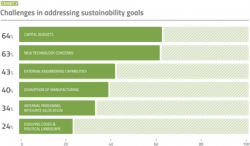It’s no secret that a push for sustainable practices influences how companies are doing work and how consumers make choices. Traditionally, sustainability has focused on environmental impact, but the definition has adopted a wider lens to include both profit and, crucially, people.
CRB’s recently released Horizons: Life Sciences report found that an overwhelming majority of large and start-up pharmaceutical and biotechnology companies (along with CMOs, CDMOs and CROs) are formalizing sustainability metrics (Exhibit 1) and/or benchmarks to measure their progress. These commitments have been made at both a corporate and project level.
Even with a commitment to formalize sustainability metrics and benchmarks, challenges remain. Is there a holistic approach companies can take to sustainability? And perhaps more importantly, can companies afford to not worry about sustainability?
Sustainability trends
Factors driving corporate commitments to sustainability have evolved in recent years. Among them are regulatory environments, evolving urgency from climate science, customer and shareholder expectations, and technology moving from a cost to a saving position.
Energy regulators are making updates to building codes to incentivize energy efficiency, which is happening in states like California with others following suit. For instance, electric heat pump technology is replacing gas-powered systems, while solar photovoltaic (PV) systems and battery storage units are helping companies ensure clean energy output.
Next, consumers and shareholders are making informed choices tied to the effects of climate change, creating an expectation for companies to transparently reduce their carbon emissions. That effort is having effects along the value chain, as organizations make their sustainability reporting part of their procurement and partnership processes.
Respondents to CRB’s survey were asked about their most significant challenge toward sustainability goals. Overall, capital budget concerns topped the list, followed closely by questions over new technology concerns (Exhibit 2).
Traditional sentiments have been tied to carbon footprint and are now morphing into something more. Profit is an essential calculation for companies when it comes to sustainability, and now, the overall well-being of people is becoming more of an important component.
Planet
Directly measurable metrics include the company’s carbon footprint numbers like electricity and transportation — two metrics for which companies can set up systems to account for and measure progress against their goals.
According to our survey, 92% of companies feature electricity when they report sustainability metrics. With electricity suppliers working to green the grid, companies don’t have to do much to report high carbon savings in this area. Transportation comes in second — and goals can also be easily met with increased use of electric vehicles (EVs) and other combustion technologies, while multimodal transportation can reduce reliance on trucks and air by increasing rail and marine transport.
Even though there are ways that companies can meet emissions goals, roadblocks like securing capital budgets and new technology concerns persist. New technology requires careful planning and upfront investments. This is a hard switch to make, especially when technology like traditional natural gas-fired equipment has been used in the past and has worked well for consumers for decades (Exhibit 3).
When technologies prove themselves more reliable in the industry over time, companies will feel more comfortable leveraging that tool in their own facilities. This makes sense as to why water and waste technologies ranked the highest among water and waste conservation measures. Plus, some respondents find that water and waste are the top sustainability categories for their company. Another factor to consider is a trend toward biotech companies using single-use technology, which creates a tradeoff. Water and energy use would be reduced, creating a downstream effect on the required utility systems. This could increase the amount of solid waste, so recycling and efficient waste management become essential.
Profit
Environmental, social, and governance (ESG) oriented corporate investing is rising, according to McKinsey & Company. This type of investment has jumped 68% since 2014 and tenfold since 2004. However, rather than looking at sustainability as an investment and a potential contribution to the bottom line, it can still be viewed as a cost. This happens because some of the more sustainable technologies may take years to show ROI. The good news is that this mentality is starting to shift with the ESG mindset.
Companies may find that not investing in these types of initiatives may cost them more in the long run. They recognize that while funding sustainable initiatives can be a challenge, there is an opportunity cost when funds are not allocated toward them. Our survey found that 44% of respondents said their company includes its supply/value chain in its carbon footprint metrics. This would put companies in the pharma industry at a disadvantage when it comes to the competitive bid process if they choose to avoid sustainability initiatives.
People
Employee health and wellness initiatives have become increasingly popular in recent years thanks to ESG practices. What’s more interesting is that nearly all survey respondents indicated that they implemented some level of an ESG in their businesses with two categories seeming to be the most popular: individual health and workplace environment.
About 75% of companies surveyed indicated they provide employees with health and wellness consultations, and more than half offer smoking cessation programs and incentives. Just shy of half of the companies are placing fitness facilities on their sites or reimbursing their employees’ gym memberships.
When the workplace environment is friendly and welcoming, it improves the overall experience and mood of the individuals inside it. Three-quarters of companies installed daylighting technology in the workplace, while more than half reported using open spaces to install walking or biking paths on-site. Though the pandemic has altered where and how we work, the initiatives demonstrate clear commitments to employee wellness and position those companies to align their values with those of their employees.
Priorities are shifting
The pharma industry sees value in implementing sustainability strategies, but these new solutions are meeting an old foe: cost. The reality of the situation is that going green in the sustainability trifecta of the planet, profit and people will only continue to grow in importance. Reframing the mindset around ESG can allow companies to improve their bottom line along and view sustainability as an opportunity, not a cost.









